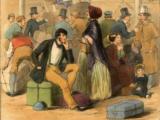Events In History
The Polynesian Panther Party was founded in Auckland by six young Pacific Islanders: Paul Dapp, Will ’Ilolahia, Vaughan Sanft, Fred Schmidt, Nooroa Teavae and Eddie Williams. The group included Samoans, Tongans, Cook Islanders, and a few Māori.
The British Nationality and New Zealand Citizenship Act 1948 (the order of the terms showed their relative importance) gave New Zealand citizenship to all current residents who had been either born British subjects or later naturalised.
The Finance Act (No. 3) 1944 abolished the poll tax introduced in 1881, which was described by Minister of Finance Walter Nash as a 'blot on our legislation'.
The Immigration Restriction Amendment Act 1920 required intending immigrants to apply for a permanent residence permit before they arrived in New Zealand.
Parliament passed the Chinese Immigrants Act, which introduced a ‘poll tax’ of £10 (equivalent to nearly $1700 today) on Chinese migrants and restricted the number allowed to land from each ship arriving in New Zealand.
En route to Auckland laden with immigrants, theCospatrick caught fire off the Cape of Good Hope. The tragedy has been described as New Zealand's worst civil disaster.
Articles
Assisted immigration, 1947-75

New Zealand is a country of immigrants. Wave after wave of peoples have settled here: Polynesian, British, European, Asian.Read the full article
Page 1 - Assisted immigration to New Zealand 1947-1975
New Zealand is a country of immigrants. Wave after wave of peoples have settled here: Polynesian, British, European,
Page 2 - Peopling New Zealand
The Labour Department was responsible for setting up and administering the assisted immigration
Page 3 - Leaving the grey UK
The Immigration Branch needed to advertise the assisted immigration scheme as widely as possible and mostly used the classified sections of British
Page 4 - The voyage out
The Captain Cook, along with the Captain Hobson, brought assisted immigrants to New Zealand via the Panama Canal from
Page 5 - Life in New Zealand
After they arrived, each assisted immigrant was given a letter of welcome from Bert Bockett, the Secretary for Labour, which outlined the assistance which the Department would
British & Irish immigration, 1840-1914

Who were the ancestors of Pākehā New Zealand? Where did they come from and what sort of people were they? These are some of the questions which this feature sets out to answer.Read the full article
Page 1 - British and Irish immigration 1840-1914
Who were the ancestors of Pākehā New Zealand? Where did they come from and what sort of people were they? These are some of the questions which this feature sets out to
Page 2 - Overview - immigration to New Zealand 1840-1914
Overview of immigration trends
Page 3 - Where did they come from?
The composition of the inflow from Britain and Ireland was quite different from the composition of the United Kingdom as a whole.
Page 4 - English immigrants
Table and graph showing which part of England immigrants to New Zealand came
Page 5 - Scottish immigrants
Table and graph showing which part of Scotland immigrants to New Zealand came
Page 6 - Irish immigrants
Table and graph showing which part of Ireland immigrants to New Zealand came
Page 7 - Where did immigrants move to?
British-born population living in New Zealand provinces in
Page 8 - Who were the immigrants?
Graph of figures taken from the death certificates of British and Irish immigrants to New Zealand (which include information on the father's
Page 9 - Conclusions about immigration 1840-1914
These statistics suggest some larger conclusions about the character and values of New Zealand's founding Pākehā
Page 10 - Further information
Further sources relating to British and Irish immigration to New Zealand, including pdfs of more detailed information and
Dominion status

On 26 September 1907 the colony of New Zealand ceased to exist. It became, instead, a dominion within the British Empire.Read the full article
Page 6 - New Zealand in 1907
What was New Zealand like when it became a
The Vogel era
In 1870, Colonial Treasurer Julius Vogel launched the most ambitious development programme in New Zealand’s history. The ‘Vogel era’ was a decisive moment in New Zealand’s 19th-century transformation from a Māori world to a Pākehā one.Read the full article
Page 1 - The Vogel era
In 1870, Colonial Treasurer Julius Vogel launched the most ambitious development programme in New Zealand’s history. The ‘Vogel era’ was a decisive moment in New Zealand’s
Page 3 - Vogel's vision
In June 1870, Vogel unveiled the most ambitious public works and assisted-immigration programme in New Zealand’s
Page 4 - Building Vogel's railways
Julius Vogel wasn’t the first colonial politician to promise to fund public works and immigration with borrowed money. But the early 1870s offered better prospects for
Page 5 - Vogel's legacy
After the initial enthusiasm of the 1870s, Julius Vogel’s reputation suffered in the 1880s when New Zealand’s economy slumped into a long depression that was triggered by an
The dawn raids: causes, impacts and legacy

The 1974-6 dawn raids have been described as ‘the most blatantly racist attack on Pacific peoples by the New Zealand government in New Zealand’s history’Read the full article
Page 1 - The dawn raids: causes, impacts and legacy
The 1974-6 dawn raids have been described as ‘the most blatantly racist attack on Pacific peoples by the New Zealand government in New Zealand’s



















